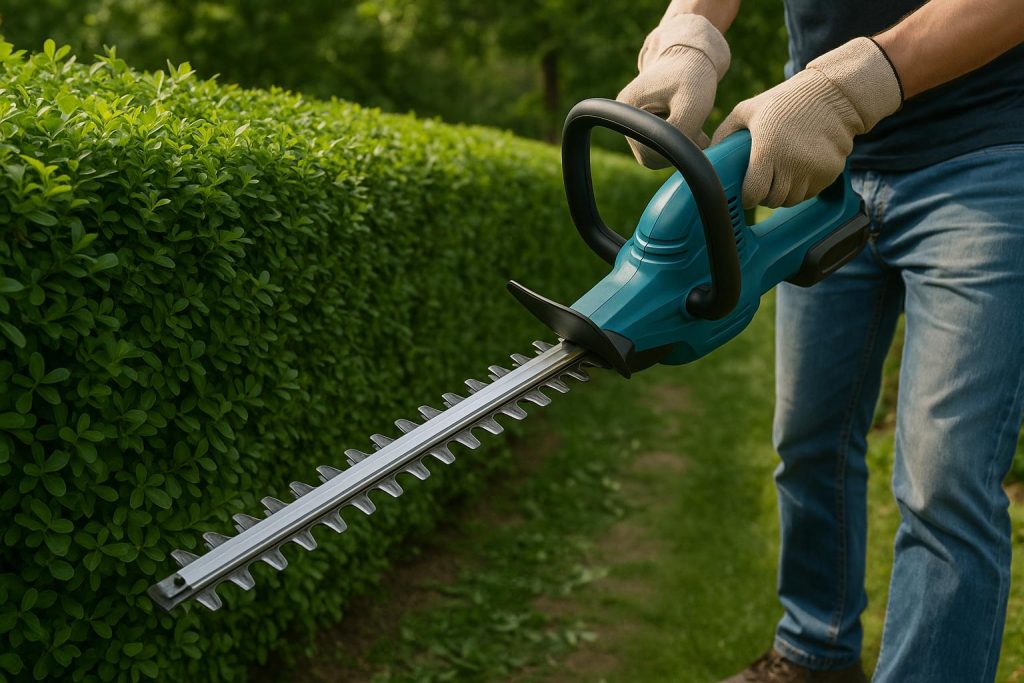In gardening, where time is always in short supply and precision is never optional, one tool has quietly become a must-have for professionals and home gardeners alike. It trims, shapes, and defines with accuracy—and it does so in minutes, not hours. Whether managing a formal boxwood border or taming a sprawling privet wall, this tool doesn’t just cut—it transforms the process.
Your workflow can be completely transformed by a high-quality hedge trimmer. With this tool, you can keep your hedges clean even during the busiest seasons without having to juggle shears, ladders, and guessing. It is becoming a necessity rather than a luxury.
Why Hedges Demand Efficient Solutions
Hedges are more than just decorative elements. They house species, control microclimates, create structural barriers, and offer privacy. However, they need frequent care because they grow quickly, particularly in temperate and tropical areas.
Unchecked growth results in:
- Irregular structure and bald spots from light deprivation
- Extra time spent on heavy corrective pruning later
Manual shears and other traditional tools take endurance and experience. On the other hand, a motorized trimmer requires less work to produce consistent cuts over extended distances. Without missing weekends or suffering from repetitive strain injuries, it enables gardeners to keep up with growth.
How Powered Trimmers Save Time
Most modern hedge trimmers are designed for both speed and precision. With dual-action blades and ergonomic designs, they cut branches cleanly in one pass. This results in less fatigue, fewer uneven spots, and faster cleanup. For large gardens or frequent trims, the time savings are substantial.
- Lithium-ion battery models run up to 60 minutes on a single charge
- Blade speeds often exceed 3,000 strokes per minute, even on entry-level units
When compared to manual choices, powered hedge trimmers can save job times by up to 70% for professionals handling commercial landscaping or homeowners maintaining dense hedges like hornbeam or laurel.
That’s one reason so many choose to purchase hedge trimmer units that match their hedge density, height, and reach needs—especially with telescopic shafts and multi-angle heads available today.
Matching Trimmer Types to Hedge Styles
Trimmers are not all created equal. Every garden requires a different tool to meet its hedging requirements. Choosing the incorrect model can result in ineffective cutting, damage to the equipment, or even damage to the hedge. Here’s how to make a decision:
- Cordless trimmers are ideal for mobility, especially in medium to large gardens
- Pole trimmers allow overhead reach without ladders, perfect for taller hedges
Users who trim for more than 30 minutes experience less arm fatigue when using trimmers that weigh less than 3.5 kg. The length of the blade is also important; for shaping, 45 cm blades work best, while for flat edges on long hedges, 60 cm or longer blades work best.
Noise, Weight, and User Comfort
Historically, hedge maintenance was a noisy, messy job. But innovations in motor design, insulation, and gear housing have brought noise levels down significantly. Modern battery trimmers now average between 85 and 95 dB, making them usable in residential zones without disturbing neighbours.
- Anti-vibration handles help protect hands from repetitive strain
- Rotating rear handles increase control around corners and edges
Users with ergonomic models report improved trimming accuracy, especially when shaping formal designs like topiary or geometric borders. Comfort plays a direct role in quality.
Hedge Health Depends on Clean Cuts
There is more to a tidy cut than appearance. Dull blades that cause ragged cuts increase surface area, which increases the risk of disease entrance and slows healing. Trimmers with sharp dual-action blades and high stroke rates are therefore recommended for stress-free, healthful hedging.
Clean cuts:
- Heal faster and reduce entry points for fungal spores
- Encourage dense branching and uniform leaf growth
Blades made from high-carbon steel retain sharpness longer, and non-stick coatings reduce sap buildup. This leads to cleaner results and less time spent cleaning the equipment.
“A gardener’s best time-saving tool is one that mimics precision with minimal motion.”
Seasonal Strategy for Trimming
Effective hedge maintenance is tied to growth patterns and seasonal timing. Cutting too early or too late can damage the plant or stunt its shape.
General timing guidelines:
- Spring: First shaping after frost risk passes
- Late summer: Last trim to hold shape into autumn
- Winter: Only for deciduous varieties that tolerate hard pruning
Forsythia and other blooming hedges should not be trimmed before they bloom. Future flower buds are then removed by cutting. To reduce damage and increase form retention, plan maintenance around growth cycles.
Sustainability: Batteries Over Gas
Older gas-powered machines are heavy, require a lot of maintenance, and emit emissions. The current trend towards battery-operated trimmers is a reflection of both financial and environmental concerns.
- Zero emissions during operation
- Low maintenance: no spark plugs, no fuel mixes
- 30–60% quieter than gas models
The reduced environmental footprint aligns with modern sustainability goals. For gardeners in noise-sensitive areas or eco-zones, battery tools are a smarter and quieter solution.
Avoiding Common Hedge Trimming Mistakes
Even with the right tool, poor trimming technique can harm plant structure. Avoid these errors:
- Over-trimming the top: Starves lower branches of light, leading to a leggy base
- Using dull blades: Causes ragged cuts and introduces pathogens
- Trimming in full sun: Leads to leaf scorch on freshly cut edges
Always trim with a slight taper—wider at the bottom—to allow light penetration. Check for nesting birds during active seasons before cutting deep into dense areas.
Storing and Maintaining Your Trimmer
The lifespan of a tool depends on routine maintenance. Blades should be cleaned with a gentle cloth and a light detergent to get rid of sap and grime after each session. To stop the blade from rusting, lubricate it with the proper oil.
- Store indoors or under cover to avoid moisture damage
- Charge batteries to 60–80% if storing for longer than two months
- Sharpen blades professionally once or twice per season for best performance
Proper maintenance not only extends the tool’s lifespan but also keeps it cutting efficiently across years of use.
Hedges as Landscape Features
A well-kept hedge gives your landscape design shape and rhythm. Whether your hedge is protecting a picnic area or framing a route, its shape and neatness set the tone for the entire environment.
Popular hedge styles:
- Formal rectangles for classical and modern gardens
- Undulating curves for a more organic look
- Topiary and cloud pruning in smaller courtyards
The cleaner the lines, the more professional the appearance. Consistency in cut height, angle, and symmetry builds visual harmony.
Where Function Meets Form
Hedges are more than just aesthetics. They offer shade, habitat, seclusion, and wind protection. They are frequently employed as microclimate barriers or living fences in permaculture projects to save more vulnerable species behind them.
Behind a clipped hedge, layered planting can retain productivity while adding visual depth. Consider wildflower strips, gooseberry bushes, or lavender rows. Defined hedging enhances these designs without taking over the arrangement.
FAQs
- What’s the average lifespan of a hedge trimmer?
Battery-powered models last 3–7 years with proper care. Blade replacements may be needed after 2–3 seasons depending on usage.
- How do I know if my blade needs sharpening?
If cuts leave ragged edges or pull at branches instead of slicing, your blade likely needs sharpening.
- Can hedge trimmers cut thick branches?
Most are rated up to 1.5–2 cm. For thicker branches, use a lopper or pruning saw to avoid damaging the trimmer motor.
- Are trimmers safe for beginners?
Yes, especially cordless models with safety switches and blade guards. Read the manual carefully and wear gloves and eye protection.
- Do I need to clean my trimmer after every use?
Yes. Sap and debris build up quickly. Wipe the blades clean and apply oil after each session to keep performance high.
What to Read Next
Examine how hedge patterns can direct wind flow, produce illusions in confined areas, or frame edible gardens with designs that serve several purposes. You’ll learn how to use layered biodiversity planting to transform common hedges into ecological assets in the following article.
Check out more on 1st-street.com








